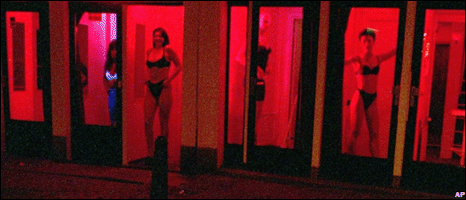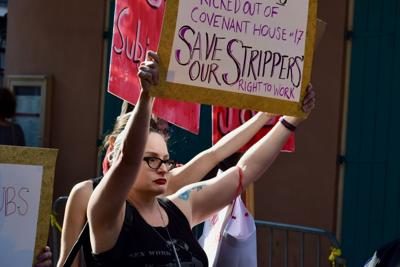
Amsterdam’s red light district. (Photo by: Lea Abecassis)
Editor’s Note: The following series Bold Females in the Big Easy is a week-long series curated by Piper Stevens as part of the Digital Research Internship Program in partnership with ViaNolaVie. The DRI Program is a Newcomb Institute technology initiative for undergraduate students combining technology skillsets, feminist leadership, and the digital humanities.
We are coming up on March 8th, a day in which the world takes a moment to appreciate the powerful contributions of the female population in celebration of International Woman’s Day. This curation takes a moment to reflect on the powerful women and women-centered movements strengthening our New Orleans community. Lea Abecassis reflects on her experience abroad in the Amsterdam and makes connections between its red light district and New Orelans’ own complicated history of sex work in the city and attitude towards sexuality. This was originally published on October 15, 2019.
My first semester Junior year I decided to study abroad in Madrid, Spain. As a child whose parents are both immigrants, my mother from Cuba and my father from Morocco, I have always been immersed into two separate cultures other than the American one I was primarily brought up in. As a study abroad student, I traveled to new cities every weekend, and one weekend my best friend and I decided to travel to Amsterdam.
Amsterdam was full of life and light, and I felt a sense of genuine happiness when I visited. I was intrigued by the smoking culture and how “normal” it was for people to be smoking marijuana. One night, however, my friend and I decided to walk through the infamous Red Light district. As we walked down the district, I remember the strong smell of smoke and alcohol and the women in skimpy outfits attempting to lure both women and men into their booths. I vividly remember observing how men would gawk at the women in the booths and look at them as if they were objects.
A specific instance that I remember most from that night was when a women left a booth and a second later a man entered. I felt as though these women were instantly being degraded and used. I was shocked as I had never been exposed to anything like this. I immediately thought to myself these women may be mothers with children, and they most definitely have mothers and fathers themselves. I almost wanted to tell these women that they did not have to do any of this.
As I returned back from this trip, I began to think about the role of sexuality in America and how, although, perhaps not as blatant as it was in Amsterdam, situations like these occur in the United States every day. Sex trafficking is an enormous industry and a major problem in America and women are being taken advantage of every day. In her book Sex Trafficking: In Our Backyard, Ranita Ray states, “…what law enforcement officials say are hundreds of active stash houses in major cities like New York, Los Angeles, Atlanta and Chicago, where underage girls and young women from dozens of countries are trafficked and help captive…promises of legitimate jobs and a better life in America…” [1].
Sex trafficking is a contemporary term created during the feminist movement in the late 1900s. During this time, many began marching for the cause of the abuse and forced prostitution of women. In the year of 2000, the United States invented the Trafficking Victims Protection Act protecting women who were kidnapped and forced into sex trafficking [2].
According to Detective Bill Woolf, who has himself met with over 300 victims, he states, “They fear law enforcement because they’re technically committing a crime and that is prostitution” [3]. These women who are frightened for their lives are being held in inhumane conditions while constantly being abused. These women feel as though this is not simply an option to take but also a lucrative decision. When society is constantly degrading women, it influences the ways in which women view themselves and enforces the idea that they will always be inferior. Ultimately, these women do not have to force themselves into these conditions; however, they may feel as though because they are being told it is normal, that they should. When women are being portrayed in subperior manners, it encourages women all around to believe that these ideas are true.

Amsterdam’s red light district. (Photo by: Lea Abecassis)
After eating an impeccable meal at New Orleans renown restaurant Revolution, my friend and I decided to stroll down the streets of Bourbon Street. We saw women completely naked — some women with their tops off yelling words of profanity. Although we are both Tulane students, the school is mostly in a bubble and unless one decides to take a trip downtown, the aspects of the city feels distant. I felt as though I was in a completely different world, and it got me thinking about the ways in which New Orleans has its own form of a “red light district.”
Aside from the delicious food, New Orleans is known for its free nature and wildness and both the French Quarter and Bourbon street are hubs for tourists who visit the city. The smell of alcohol lingers around the multiple bars and strip clubs that line Bourbon street. Kevin Little, author of a Times Picayune article states, “Bourbon street has become a playground for pimps – the kingpins of a brutal and sadistic underworld that hides in plain site” [4]. The street’s wild and captivating nature to tourists has also become a dangerous place for girls and women. Club owners themselves feel as though Bourbon Street specifically has been an instrumental factor to perturbing atmosphere.
Although little is left of it, New Orleans itself has had a red light district: Storyville. Prostitution became illegal in Storyville in 1917; however, before then, it was crowded with brothels and saloons. Although jazz music did not originate in Storyville, many brothels would hire musicians to play. Once prostitution became illegal in 1917, the district began to lose its appeal and began to deteriorate [5]. Moreover, during the Secretary War of 1917, the US Navy would stay in New Orleans. However, Newton D. Baker was not pleased with the idea of military soldiers engaging in “unethical” activity and ultimately urged the government to shut down Storyville [6].
Since then, New Orleans has been a place riddled, just as much of the world is, with sexual assaults. In fact, in 2018, a 16-year-old girl was liberated from a hotel on Canal Street after the police were notified that “she was being held against her will, repeatedly raped, drugged and beaten” [7]. This horrifying story could be a case of human trafficking, which happens in the city and police say most of human trafficking goes undetected and is very hard to identify [8]. Sex trafficking in New Orleans has been a recent topic and Louisiana passed two bills that if passed, will connect New Orleans strip clubs with human trafficking [9]. The reason this law poses a challenge is because it can potentially put the sex workers at a great risk. HB830 states that “sexually oriented businesses” must fulfill certain requirements that include questionnaires, and if not, are fined thousands of dollars. The second bill, SB335, increases fines for those who both engage for sexual activity with with sex workers in hopes to decrease the demand [10].

Signs of support for sex workers. (Photo by: Lea Abecassis)
In February of 2018, strip club employees and others passionate about anti-trafficking headed to the French quarter to object the police attacks on these clubs. Police claimed that by raiding these strip clubs, they were assisting in ending human trafficking by shutting down these establishments. However, some of the women and sex workers felt as though the policemen made them feel completely degraded and took pictures without consent. Not only are police a form of safety and security, but for these policemen to make these women feel unprotected and violated is completely unacceptable. When high positions of authority are not displaying their respect for women in even the smallest of ways, it further encourages society to regress in the ways in which it views women.
Defeatiation is a neologism that translates to when a problem that impacts the world or even the smallest community has been overcome or defeated. Human trafficking and sex trafficking has not been conquered. It is a global challenge that is extremely hard to combat for various reasons. Beneath both the red light district and human trafficking, there is a sense of complete ignorance for humanness.
Since my experience in Amsterdam, I have been passionate about the issue of trafficking and how women are being taken from their families and abused all over the world. These women have the potential to be outstanding individuals in this country, but instead, they are captured and forced into a life that they cannot escape from. Joan Didion states “To make an omelettes you need not only those broken eggs but someone oppressed to beat them” [11].Women have been oppressed for centuries and are constantly being degraded and demeaned. Sex trafficking can happening anywhere.
Sources:
[1]Armaline, William T., et al. Human Rights in Our Own Backyard: Injustice and Resistance in the United States. University of Pennsylvania Press, 2011.
[2]“Combating Sex Trafficking: A History.” Fair Observer, Fair Observer, 8 May 2014, www.fairobserver.com/region/north_america/combating-sex-trafficking-history/.
[3]Alvarez, Priscilla. “When Sex Trafficking Goes Unnoticed in America.” The Atlantic, Atlantic Media Company, 26 Feb. 2016, www.theatlantic.com/politics/archive/2016/02/how-sex-trafficking-goes-unnoticed-in-america/470166/.
[4]Litten, Kevin. “The Track: How Sex Trafficking Has Taken Hold of Bourbon Street.” NOLA.com, NOLA.com, 18 Oct. 2017, www.nola.com/politics/2017/10/the_track_how_sex_trafficking.html.
[5]Branley, Edward. “NOLA History: The Legendary Storyville District.” GoNOLA.com, GoNola, 24 Jan. 2019, gonola.com/things-to-do-in-new-orleans/arts-culture/nola-history-the-legendary-storyville-district.
[6]Branley, Edward. “NOLA History: The Legendary Storyville District.” GoNOLA.com, GoNola, 24 Jan. 2019, gonola.com/things-to-do-in-new-orleans/arts-culture/nola-history-the-legendary-storyville-district.
[7]Prentzel, Olivia. “Here’s What Experts Want You to Know about Human Trafficking in New Orleans.” NOLA.com, NOLA.com, 26 Jan. 2019, www.nola.com/crime/2019/01/heres-what-experts-want-you-to-know-about-human-trafficking-in-new-orleans.html.
[8]Prentzel, Olivia. “Here’s What Experts Want You to Know about Human Trafficking in New Orleans.” NOLA.com, NOLA.com, 26 Jan. 2019, www.nola.com/crime/2019/01/heres-what-experts-want-you-to-know-about-human-trafficking-in-new-orleans.html.
[9]In These Times, inthesetimes.com/working/entry/21173/New-Orleans-Louisiana-gentrification-sex-work-trafficking-strip-clubs.
[10]In These Times, inthesetimes.com/working/entry/21173/New-Orleans-Louisiana-gentrification-sex-work-trafficking-strip-clubs.
[11]The Women’s movement by Joan Didion
 NOLAbeings Multimedia artist Claire Bangser created NOLAbeings as a portrait-based story project that marries...
NOLAbeings Multimedia artist Claire Bangser created NOLAbeings as a portrait-based story project that marries...  Voodoo in New Orleans: Reviving history: New Orleans fortune telling This article takes a deep dive into the history of Voodoo in New Orleans, its hybridization with Catholicism, and its present-day place in the city's culture. The author visits fortune-tellers in the French Quarter, using their guidance as a tool for introspection rather than a deterministic predictor of the future. Through her experiences in New Orleans, the author feels a mystical connection to both the past and the future.
Voodoo in New Orleans: Reviving history: New Orleans fortune telling This article takes a deep dive into the history of Voodoo in New Orleans, its hybridization with Catholicism, and its present-day place in the city's culture. The author visits fortune-tellers in the French Quarter, using their guidance as a tool for introspection rather than a deterministic predictor of the future. Through her experiences in New Orleans, the author feels a mystical connection to both the past and the future. 